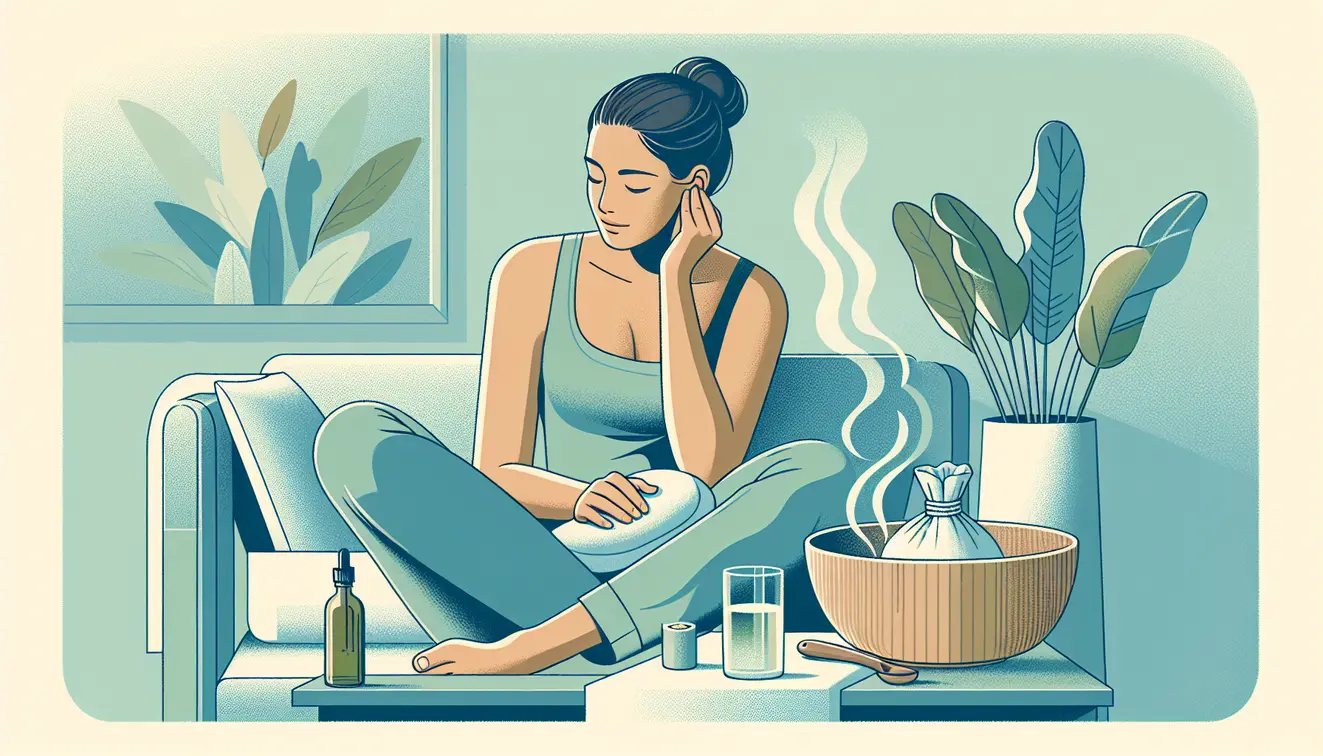Home Remedies for Clogged Ear: Safe and Effective Solutions You Can Try at Home
Estimated reading time: 10 minutes
Key Takeaways
- Clogged ears are often caused by earwax buildup, fluid from colds, or pressure changes.
- Safe home remedies include warm water irrigation, olive oil drops, and steam inhalation.
- Avoid harmful practices like ear candling and misuse of cotton swabs to prevent injury.
- Seek medical attention if symptoms persist beyond a few days or include severe pain.
- Prevent future issues with gentle ear cleaning, hydration, and travel precautions.
Table of Contents
- 1. Introduction to Clogged Ears: Understanding the Discomfort
- 2. What Causes a Clogged Ear? Identifying the Root of the Problem
- 3. Safety First: Important Precautions Before Trying Home Remedies
- 4. Top 10 Home Remedies for Clogged Ears: Step-by-Step Solutions
- 5. What to Avoid: Harmful Practices That Can Worsen Clogged Ears
- 6. When to See a Doctor: Recognizing Red Flags
- 7. Prevention Tips: How to Avoid Clogged Ears in the Future
- 8. Frequently Asked Questions (FAQs): Quick Answers to Common Concerns
1. Introduction to Clogged Ears: Understanding the Discomfort
Have you ever felt like your ear is blocked, with sounds muted and a strange pressure lingering? That’s the discomfort of a clogged ear, often paired with irritation or a sense of fullness. It can disrupt your day, making simple conversations or quiet moments uneasy.
But here’s the good news: clogged ears are usually temporary and can often be eased with gentle, natural solutions. At WikiHomeRemedies, we’re committed to guiding you through safe, trusted approaches rooted in science and time-tested wisdom. Our mission is to empower you with natural remedies, drawing from reputable sources like NIH and WebMD, to help you rediscover comfort. If you’re dealing with related ear issues, explore more solutions with our guide on Home Remedies for Blocked Ears.
Did you know that earwax buildup alone impacts roughly 1 in 10 adults, according to NIH studies? Whether it’s wax or another trigger, this guide will walk you through understanding the root of the issue and finding relief right at home. Let’s explore what might be causing this and how to address it with care.
2. What Causes a Clogged Ear? Identifying the Root of the Problem
Before jumping into solutions, let’s uncover what might be behind that blocked feeling in your ear. Pinpointing the cause is the first step to choosing a remedy that truly helps. Often, the culprit is something as common as earwax buildup, which hardens over time and traps sound.
Another frequent trigger is fluid from a cold or allergies, congesting the Eustachian tube that connects your ear to your throat. Have you flown recently or driven through mountains? Changes in air pressure can also create that stubborn blockage. Other culprits include sinus infections, which swell the passages, or swimmer’s ear, where water lingers and irritates. For related sinus issues that might contribute to ear congestion, check out our article on Home Remedies for Sinus.
Knowing the source matters immensely. As the Mayo Clinic notes, earwax issues are widespread, while WebMD highlights how colds often lead to Eustachian tube dysfunction. Here are a few common causes to consider:
- Earwax buildup, blocking the canal.
- Fluid trapped from colds or allergies.
- Pressure shifts during travel or elevation changes.
- Sinus infections adding to ear congestion.
- Water retention after swimming.
Understanding what’s at play ensures you pick the right path to relief. Let’s move forward with caution in mind to keep your ears safe while seeking comfort.
3. Safety First: Important Precautions Before Trying Home Remedies
Easing a clogged ear at home can be simple, but safety must come first. Not every remedy suits every situation, and rushing in without care might worsen things. We want you to feel confident and protected as you try these natural solutions.
Start with a few key precautions. Never attempt remedies if you’re experiencing sharp pain, fever, or dizziness—those could signal something serious. The Cleveland Clinic warns against improper ear cleaning, which can harm delicate tissues. Here are some essential guidelines:
- Avoid using cotton swabs; they often push wax deeper.
- Stick to lukewarm liquids or materials to prevent burns.
- Stop any remedy if discomfort increases.
- Consult a doctor if symptoms don’t improve or worsen within a few days.
Special care is needed for children, pregnant individuals, or anyone with existing ear conditions. If there’s even a hint of a perforated eardrum, skip home treatments entirely. With these safeguards in place, you’re ready to explore remedies tailored to bring relief. For more on ear-related health precautions, see our post on Home Remedies for Earaches.
4. Top 10 Home Remedies for Clogged Ears: Step-by-Step Solutions
Now that we’ve covered the groundwork, let’s dive into practical ways to clear that blocked ear. These 10 remedies are rooted in both science and tradition, designed to tackle specific causes like wax or pressure. Follow the steps closely, and always keep safety in mind as you try them.
4.1 Warm Water Irrigation
This gentle method helps flush out earwax safely. Grab a bulb syringe, fill it with lukewarm water—not hot—and tilt your head to let the water flow into the affected ear. Let it sit for a moment before tilting to drain. According to Mayo Clinic guidelines, this softens and removes wax effectively. Just ensure there’s no chance of a perforated eardrum before starting.
- Use water at body temperature to avoid dizziness.
- Gently squeeze the syringe; don’t force it.
- Stop if you feel pain or pressure.
4.2 Olive Oil or Mineral Oil Drops
Warm a small amount of olive oil or mineral oil, then place 2-3 drops into your ear using a dropper. Tilt your head for a few minutes to let it soften the wax, then drain. Healthline and Cleveland Clinic endorse this for easing wax out naturally. Keep the oil just warm, never hot, to protect your ear.
- Test the temperature on your wrist first.
- Lie down to let the oil penetrate.
- Use a tissue to catch draining oil.
4.3 Valsalva Maneuver for Pressure Relief
If pressure from travel or a cold is the issue, try this. Pinch your nose, close your mouth, and blow gently as if inflating a balloon. This can pop open the Eustachian tubes, as WebMD explains. Don’t push too hard—stop if it hurts.
- Breathe normally before attempting again.
- Repeat only a few times if needed.
- Avoid if you feel sharp discomfort.
4.4 Steam Inhalation
Steam can loosen mucus blocking your Eustachian tubes. Boil water, pour it into a bowl, and lean over with a towel draped to trap the steam. Breathe deeply for 5-10 minutes, per Everyday Health suggestions. Keep a safe distance to avoid burns.
- Add a drop of essential oil if desired.
- Rest afterward to let mucus drain.
- Ensure the steam isn’t scalding.
4.5 Warm Compress
A warm cloth placed against your ear for 5-10 minutes can encourage drainage and soothe tension. Heat promotes fluid movement, as noted by the Cleveland Clinic. Make sure the compress isn’t too hot before applying.
- Reheat the cloth if it cools quickly.
- Relax while holding it in place.
- Check skin for redness or irritation.
4.6 Jaw Exercises and Yawning
Sometimes, moving your jaw helps. Chew gum or force a yawn to stimulate the Eustachian tubes, opening them naturally. Healthline supports this for pressure relief. Skip this if you have jaw pain already.
- Try chewing for a few minutes.
- Yawn widely to maximize effect.
- Stop if discomfort arises.
4.7 Hydrogen Peroxide Solution (Diluted)
Mix equal parts water and 3% hydrogen peroxide, then apply a few drops to your ear. Wait as it bubbles to break down wax, then tilt to drain and rinse with warm water. Medical News Today confirms its efficacy. Don’t use if your ear feels irritated or injured.
- Use only a diluted solution.
- Rinse thoroughly after a few minutes.
- Avoid overuse to prevent dryness.
4.8 Nasal Irrigation with Saline
Clearing nasal passages can ease ear congestion. Use a neti pot or saline spray with sterile water to flush out mucus. Verywell Health notes this reduces sinus pressure impacting ears. Always use clean equipment to prevent infection. For additional nasal congestion relief tips, refer to our guide on Home Remedies for Nasal Congestion.
- Follow package instructions for neti pot use.
- Tilt head to avoid water entering ears.
- Use only distilled or boiled water.
4.9 Hydration and Rest
Sometimes, the simplest fix is best. Drink plenty of water and rest if a cold is the cause. Harvard Health explains that hydration thins mucus, aiding drainage. There’s no downside—just let your body recover.
- Sip water throughout the day.
- Rest in a quiet space.
- Pair with other remedies if needed.
4.10 Vinegar and Alcohol Solution
After swimming, mix equal parts white vinegar and rubbing alcohol, applying a few drops to each ear. This evaporates trapped water and curbs swimmer’s ear, as Reader’s Digest suggests. Avoid this if your ear feels sore or raw.
- Tilt head to let solution drain out.
- Use post-swimming to prevent issues.
- Stop if stinging occurs.
These remedies offer a range of paths to relief, tailored to what’s causing your discomfort. Try them with patience, and remember that not every method works for everyone. If one doesn’t help, there are others to explore.
5. What to Avoid: Harmful Practices That Can Worsen Clogged Ears
While seeking relief, it’s just as important to know what to steer clear of. Some practices can turn a minor issue into a bigger problem. Let’s ensure you’re not unknowingly making things worse while trying to help your ears.
Ear candling, for instance, is a risky trend with no proven benefit. The FDA and Harvard Health warn that it can cause burns or even damage your ear canal. Then there’s the misuse of cotton swabs, which Mayo Clinic notes often pushes wax deeper, creating tighter blockages. Ignoring symptoms for too long is another misstep—don’t delay if discomfort lingers.
Here are a few harmful habits to avoid:
- Ear candling, due to burn and injury risks.
- Forcing objects like swabs into the ear canal.
- Overlooking worsening pain or hearing loss.
Staying mindful of these pitfalls keeps you on track for safe recovery. If home efforts don’t bring ease, it might be time to consult a professional.
6. When to See a Doctor: Recognizing Red Flags
Home remedies work wonders for many, but some situations call for expert care. Knowing when to step away from DIY solutions can prevent complications. Let’s talk about the signs that mean it’s time to see a doctor.
If your ear stays clogged for over 3-5 days, or if you notice severe pain, hearing loss, or unusual discharge, don’t wait. WebMD points out these could signal infections or deeper issues needing medical tools for safe cleaning or diagnosis. Fever or dizziness also warrant a visit—your health comes first. For insights on related ear infections that might require medical attention, read our detailed post on Home Remedies for Ear Infections.
During a medical check, expect a thorough exam, possibly earwax removal, or tests to uncover hidden causes. Acting sooner rather than later protects your hearing and comfort. Trust your instincts if something feels off, and reach out for help without hesitation.
Here are key red flags to watch for:
- Persistent blockage beyond a few days.
- Sharp pain or sudden hearing changes.
- Discharge, fever, or balance issues.
7. Prevention Tips: How to Avoid Clogged Ears in the Future
Clearing a clogged ear feels great, but preventing it from happening again is even better. With a few mindful habits, you can lower the chances of facing that muffled discomfort. Let’s explore practical ways to keep your ears healthy.
1. Earwax Management
- Clean ears gently with a washcloth, avoiding deep insertion.
- Don’t over-clean; natural wax protects, per Cleveland Clinic.
- See a professional if buildup feels frequent.
2. Protect During Travel
- Chew gum or use earplugs during flights for pressure balance.
- Swallow often to open Eustachian tubes.
- Stay hydrated to ease mucus flow.
3. Avoid Water Retention
- Dry ears thoroughly with a towel after swimming or showers.
- Tilt head to drain lingering water.
- Use swimmer’s ear drops if needed, post-exposure.
4. Boost Immune Health
- Wash hands often to dodge colds, as NIH advises.
- Manage allergies to prevent sinus congestion.
- Rest and hydrate to support recovery.
These steps tackle the root triggers of clogged ears, from wax to colds. Build them into your routine, and you’ll likely sidestep future discomfort with ease.
8. Frequently Asked Questions (FAQs): Quick Answers to Common Concerns
Still have questions about clogged ears? We’ve gathered some of the most common queries to provide clear, helpful answers. Let’s address your concerns with straightforward guidance.
- Can a clogged ear resolve on its own? Yes, many cases clear up in a few days, especially from pressure or minor wax. Remedies can speed things along for faster comfort.
- What is Eustachian tube dysfunction? It’s a blockage in the tube linking your ear and throat, often causing pressure or fullness, triggered by colds or allergies.
- Which remedies work best for earwax vs. pressure? For earwax, try warm water irrigation or olive oil drops. For pressure, the Valsalva maneuver or jaw exercises often help most.
- Are home remedies safer than over-the-counter drops? It depends on the product. Natural options like oil can be gentler if used right, but always check ingredients and follow safety tips.
These responses aim to clarify lingering doubts, ensuring you feel equipped to handle a clogged ear. If anything remains unclear, revisiting the remedies or precautions might offer further insight.










